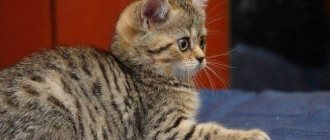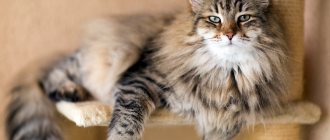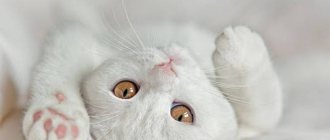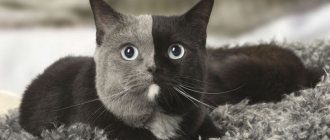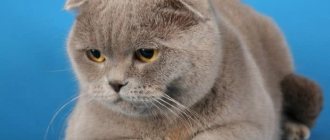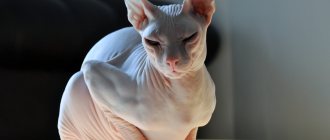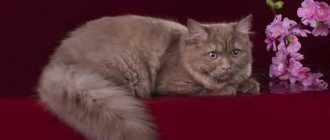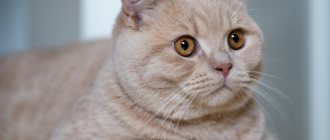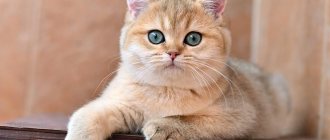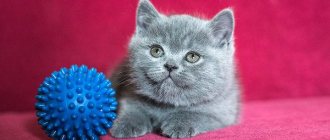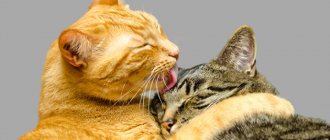A little about the breed itself
Cats of this breed are short-haired and have a characteristic face. They are mainly distinguished by their kindness, strength of character and intelligence. At the same time, their body sizes generally correspond to medium or large; the animals are called strong and strong.
They say that the British are direct descendants of the well-known Cheshire cat.
External features of animals
If you take into account the coat color of cats, you will notice that their appearance has certain patterns. These include:
- Round head and wide cheekbones;
- Short and rough neck;
- Short and straight nose,
- Small and low-set roundish ears;
- Big eyes;
- Grounded, massive body;
- Short but fairly thick paws;
- Thick, medium-sized tail;
- Short, soft, but very thick coat.
© shutterstock
Character and behavioral characteristics
The main difference between Britons is that they are very independent from their owners. It is convenient to have such animals for businessmen or those who like to travel, because the cat will not be too sad during separation.
They will not cuddle and bask in the arms of their owners. However, this does not mean that the British do not love their partners. The main thing for them is just to be nearby, and they also love to play and “talk.” At the same time, the cat will not escape from the hands, but will calmly withstand all the outbursts of tenderness of the owner. Such a British temperament in an animal.
Positive and negative sides
Like any animal, the British dog also has its pros and cons. The first is that he does not require much attention and can easily be left alone for long periods of time. However, the negative aspects include the severity of upbringing, since they almost always have their own opinion about everything and their own vision of what they need to do.
© shutterstock
Description of the breed
The blue British shorthair cat is one of the most popular cats in Russia at the moment. It’s very simple to answer the question “why”, just look at the photo: a large body with powerful paws, short fur of an amazing color with a thick undercoat, a regular shaped head with round large eyes of yellow shades, plush cheeks and... a smile!
Yes, it is the special structure of the faces of these aristocratic cats that creates the illusion of a friendly smile, for which they are quite justifiably compared to the Cheshire Cat from the famous Disney cartoon.
It is worth noting that two different breeds should not be confused: the British Shorthair and the Scottish Fold. A blue fold cat has quite a lot in common with a cat of the British breed, and the kittens of these breeds in the photo are very similar, but generalizing them is quite a big misconception.
If you decide to choose a blue British Shorthair kitten, then you should contact well-known nurseries in your city that specialize in breeding this breed. There you can carefully examine the kittens: touch, stroke and observe the behavior of the future pet.
First of all, the kitten must be at least 12 weeks old and have clean, plush fur, skin without damage, and mucous membranes of the eyes without swelling or redness. The animal should be playful and inquisitive; lethargy and apathy are, on the contrary, a bad sign.
- Exhibition kittens are classified as Show - this means that the appearance and character of the cat must ideally correspond to the standards of the breed. Such animals must easily endure travel, large crowds of people, and be able to show themselves and their character at exhibitions without embarrassment or timidity.
- The Breed category includes kittens for which their pedigree is very important, because animals of this class are bred for subsequent breeding. They can also participate in exhibitions, but their main criterion should be the ability to pass on the best breed qualities from generation to generation.
- The Peet category is assigned to the British "domestic type". Such animals may have minor defects or abnormalities, or may be too shy to be shown or posed for photographs. Of course, the presence of defects in this category is not at all necessary, but they do occur. However, the criterion for these animals is ideal adaptability to keeping a home, without losing the basic qualities of the breed.
Of course, the most important thing is that a purebred British Blue kitten must have a veterinary passport with vaccinations and a full description of the pedigree, and its breeder must have a certificate or other document confirming experience in breeding.
Colors of British cats
Today, the colors of the British Shorthair are known in more than 200 variations. A small part of them has been known since the appearance of the breed in general, the other is a consequence of the painstaking work of breeders.
The very variety of colors depends on the combination of two components - the color of the animal’s villi and the presence of a pattern on their body.
Melanin is responsible for what kind of pattern will be shown on the British fur coat. At the same time, two different types of substances can give a black or red base, which ultimately acts as a key in the formation of color. The combination of these two types of melanin in different proportions allows you to create very diverse animals in appearance. In addition, it is worth noting that there are solid colors - when the wool is one color, as well as wool with a pattern.
Find out what drawing by numbers is and what makes it special
With the help of this direction, a unique opportunity arises to create paintings in a variety of techniques and genres of painting. The interesting thing is that once the work is completed, it is difficult to distinguish the writing method.
This hobby opens up scope for creativity, because after learning what drawing by numbers is, you will want to plunge into drawing headlong. Thus, you can create entire masterpieces simply by painting numbered surfaces with paints.
Drawings by numbers - what is it and what is needed for them?
Having become familiar with what painting by numbers is, you can begin to use the technology. The cells into which the entire canvas is divided are painted with numbered paints. Therefore, for each painting the kit includes its own set of paints and an example of the finished painting.
Essentially, the whole work consists of two stages:
1. Preparation of paints.
In order not to damage the bottle, you need to open it with extreme caution. At this stage, it is worth taking a responsible approach to the preparation of paints, which involves adjusting the viscosity. Paint that is too thick needs to be thinned with water. To do this, add water using a brush in small drops. You can stir the paint with a match or a toothpick (it is also used for painting small parts).
2. Drawing.
It is best to do creative work in a bright, spacious place. To make it convenient to do this work, you should place the following items near you: a palette of paints, a brush, a control sheet, a glass of water, matches, a piece of cloth.
You need to start writing the canvas by tracing the contours, which is done with a toothpick. Then you can start painting the surface. If the marks on the surface or the contours are visible, the paint application must be repeated a couple of times.
Painting by numbers - what is it and what are the methods of coloring?
There are two methods of applying paint:
• line by line, which means painting the canvas from the top edge to the bottom;
• background, then foreground. In this case, objects in the background are painted first, and then in the foreground. This method is believed to achieve better results.
Popular varieties
Speaking about the diversity of British cats and taking into account the components that were mentioned above, they can all be grouped into certain categories. It is in such groups that we will further consider:
- blue;
- monochrome and smoky;
- white;
- Collor Point;
- silver and gold shaded;
- tortoiseshell cats;
- Tabby;
- Bicolor, Party-colors, Harlequin, Van.
© shutterstock
Blue plain
Due to the great similarity of cats of this breed to the Scottish Fold, mainly those who want to have an animal think that the color must necessarily be blue. This color is indeed recognized as a certain standard. Quite often in colloquial speech they are called classic.
The fur of such British cats is mostly monochromatic and does not have any light-colored fibers. The skin of animals is always blue, but it is the light shade of the coat that is much more valuable to specialists ; moreover, at the age of the kitten, some kind of pattern may exist, but with age it necessarily disappears.
Drawing Method:
| 1. Prepare your work area. Cover the table so it doesn't get dirty. Prepare jars of water for rinsing your brushes. | 2. Fill the numbered areas with paint of the appropriate color. | 3. Fill in all areas with the same color first, going from large areas to small ones. Start at the top and work your way down. | ||
| 4. Always start with large areas and gradually move to small ones that are more difficult to paint. | 5. Try to control the brush to carefully fill in the areas and not go over the edges. | 6. Show off your finished masterpiece to others. Frame your painting and hang it on the wall. | ||
ATTENTION:
- Do not give this product to children under 3 years of age.
- The paints are not edible. If paint gets on your mucous membranes or clothing, rinse immediately with water.
- You can choose the order in which the colors are applied as you wish. If you accidentally used the wrong color, paint over it with the correct paint.
- To prevent the paint from drying out, close the bottle tightly until you use it.
- Wash your brush thoroughly before using each new paint.
- Color shades may vary slightly from the photo on the box.
Myths and their refutation
Although photos and descriptions of the colors of British cats can be easily found both on the Internet and on the pages of specialized magazines, many people quite often make mistakes in their thoughts. For example, most cat lovers think that a Briton of this category is born with bright orange eyes. But this is not so - British kittens of all colors appear with blue and sometimes gray eyes, the iris of the eye acquires a different color only later. Another mistake cat owners make is that they do not know about the existence of the British Shorthaired Fold.
CHARACTER
If you decide to get a British Blue cat, get ready to interact with a friendly and affectionate pet. Representatives of this breed are distinguished by their good manners, restraint and balance.
But at the same time, the British are extremely active and love to play. That's why children are especially delighted with them. Blue British cats are extremely curious and restless. They are very interested in the world around them.
Calm comes to these representatives of the animal world over the years. They become more important and sedate. The truth here is that much depends on the psychological situation in the master’s house.
Plain
Representatives of this group are considered to be those animals in which all the villi, the layer under the fur and the skin are strictly one solid color or even shade. Literally one small spot is the reason why a Briton is not enrolled here. This group includes colors:
- Lilac;
- Chocolate;
- Black;
- Cinnamon;
- Faun.
© shutterstock
Lilac cat
Animals of this breed have a uniform color that combines blue and pink tones. You can notice that these animals have pink hair color, which is difficult to explain in words. Therefore, before making a choice, you should first look at the photos of the colors of British cats.
Interestingly, adult cats are similar in color to delicate milk coffee. Of the entire set of color components, only the undercoat can have an excellent tone.
It is quite difficult to obtain an animal of this color, because quite often it is just luck and a consequence of the unpredictability of the actions of breeders.
Chocolate animals
This coat color is primarily a one-color kitten with increased pigmentation of the fibers. For them, there is one pricing law: the darker the color (shade) of a brown British cat, the more expensive it is. People can easily hear this shade called “chestnut” or “havana”.
Black color of the breed
These Britons are characterized by a deep and highly saturated black tone of the body, which covers the villi, undercoat and even the entire skin. These animals are very difficult to breed because their fur begins to fade at the age of seven months. Quite often, a kitten that was born black can become brown in just one year . Such British people generally cannot have a silver shimmer. If it exists, then this means that the breeders tried hard to produce a kitten. And such a violation results in the animal being rejected on the list of rejected ones.
Cinnamon color
Shades of this light brown color are rare colors of British cats. After all, at first they were light tones of a chocolate type color, but over time they were crossed by two carriers of this gene. Their rarity is manifested in the fact that a brown British cat can give birth to such heirs only after one generation, and sometimes much less often.
Maintenance and care
Almost all breeds with this color are more valuable when the contrast between the base color and the pigment parts is strong. Therefore, the main task of a person is to maintain the correct color. In addition to temperature, other factors also affect color.
The first one is age. As stated earlier, almost every cat darkens over time.
Any damage can also change the color of fur and even skin. In areas where injury or surgery has been performed, the fur will be much darker. This is due to the fact that that area of the body will become much colder. In some cases, color may return after the first molt, but this does not always happen.
White British
Such animals are characterized by a cold tone of the villi and a pinkish tint to the skin. In nature, there is a British white cat with blue eyes, as well as multi-colored ones. Kittens may have a small spot, but it should definitely disappear over time.
© shutterstock
At the same time, the British, in which yellowing still appears in specific places - on the paws, hair under the eyes, and also on the tail, are considered to be defective.
Collor Point breed
These animals include those in which there are two colors in color, but white significantly predominates. The second color can range from gray with a lighter shade to red. The most expensive representatives of the breed with a very rare Siamese type color with dark colored locks.
Silver and gold shaded
Representatives of this category are characterized by the presence of the main color on the ears, head, back and even on the tail. In this case, the silver shade should predominate on the collar, paws and belly. Quite often, all owners of this color are mistakenly called chinchillas. Among them are the colors of the coat:
- brown or black;
- blue;
- chocolate;
- cinnamon;
- faun
Silver chinchilla
If we talk about what colors British silver cats come in, then this category can be classified as the rarest. Thanks to the direct connection with representatives of the Persian breed, they have a more flexible and softer character.
At the same time, they have an important feature - the hairs should not be silver more than one-eighth of the length.
Golden color type
In this group of animals, the base tone is necessarily dark, and the upper part of the hair is painted gold. A gray tint in this case is not acceptable, and therefore such cats are considered defective. People call them chinchillas.
© shutterstock
Turtle animals
Owners of tortoiseshell colors are characterized by a uniform distribution of tones on the body, but with the condition that there are no patterns on the light parts. The presence of red or cream spots on the face is acceptable . This species, due to genetic predisposition, is only possible for females, which makes the work of breeders even harder. Another injustice is that the British in this category are infertile. For animals, a combination of 3 colors is important:
- black or brown;
- cream/red;
- blue or purple.
Patterned (Tabby)
Another species that contains a table of colors of British cats. What is characteristic of these Britons is that they can have excellent hair color at the very base. The pattern on the body can be striped or spotted. It is advisable to divide them into silver and gold types; sometimes a subspecies of the Collor Point type is also distinguished.
Snow (asymmetrical) leopard color
This type of tabby is characterized by large dark spots on a light-colored coat. The pattern practically cannot be symmetrical, and the spots themselves are dark inside and less saturated along the contour. On the lateral areas of the skin there are thin stripes resembling marble. The kittens' eyes are large and copper-colored. The base tone can be anything.
The brighter the color of the ornament in the first months of the animal’s life, the better it will be preserved as it grows.
Whiskas
Like all British cats, this one has a special charm. Silvery fur with a clear pattern on the body characterizes representatives of this group. The main feature is three solid lines on the back of the animal. His eyes are always bright orange .
The base is a light gray color, respectively, the line is dark gray or black.
All types of colors of British cats
The entire range of colors that the British Shorthair cat breed has is divided into color groups:
- solid (plain)
- patterned (tabby, tabby)
- combination of primary color with white (bicolor, harlequin, van)
- tortoiseshells
- color point (Siamese type)
- silver
- golden
Solid colors
This group includes seven types of color. It includes blue, lilac, chocolate, black, red, cream and white, which can come with different eye colors - blue or orange. The solid color should be uniform throughout the cat's body, without any spots or stripes. Each hair is dyed evenly from the root to the very tip; hairs of a different color than the main one are not allowed to appear.
The most popular are the blue and lilac colors of British cats. The blue color can be described as an ash-gray coat color with a hint of blue in both light and intense saturation. The tips of the hairs should not be bleached or silver, which is sometimes found in British blue cats. Eyes can be all shades of orange up to the color of copper, and the richer the better.
The lilac color of the coat is a light gray coat with a pinkish tint. The presence of any spots or stripes is considered a fault. Eye color can vary from amber to copper.
The British chocolate-colored cat is much less common; offspring with a coat of this color can only be obtained from cats with a certain set of genes. The “chocolate” coat should be evenly dyed a dark chocolate color. A common defect in chocolate-colored cats is the lightened lower part of the hairs, which is considered a defect.
The miniature panther is a black British cat. This is the most stable and reliable color of the entire palette of cat colors. However, a couple of white or light hairs will still break through a perfectly black coat. It is impossible to get a black kitten from a non-black couple. Even if its fur appears black, then genetically such a kitten is still only half black. Many breeders believe that the British cat, whose color is black, is the most ideal sire. And all because they have better breed characteristics, in comparison with animals of more exotic colors.
Thanks to the efforts of breeders, the breed of British cats acquired the cinnamon and fawn colors. Animals with this coat color are still considered rare. Cinnamon color is also called ground cinnamon color. It was obtained by lightening the chocolate color of the coat, and the fawn, in turn, is a lightened cinnamon color.
Tortoiseshell colors
The British tortoiseshell cat combines two colors on its coat. It can be black and red or blue and cream. They also come in chocolate cream and lilac cream tortoiseshell. Spots of these tones should be evenly distributed throughout the cat's body; there may also be spots of different colors on the paw pads. Due to genetic characteristics, this color is found only in cats.
Even with the help of selection and knowledge of the genetics of colors, it will still not be possible to predict in advance how the colors will mix in the tortoiseshell color of the offspring. Therefore, judges do not impose strict requirements on them. In breeding, cats of such colors are simply irreplaceable, because kittens from them can be of all kinds of colors.
Patterned colors
This is a group of colors that combines three different types of patterns on a cat's coat. According to the breed standard it is brindle, marbled or spotted. Each of these patterns is placed, as it were, on top of the main color of the animal, which creates a simply huge range of colors. But regardless of the color and type of pattern, all such animals have a common name - British tabby cat.
All of these colors have a number of requirements that are common to each individual color: all stripes, lines and spots must be clear and contrasting. It is also necessary to have decorating stripes on the paws and chest, rings on the tail, and the letter “M” on the forehead. The nose and eyes must be outlined in the same tone as the main color.
Gold or silver background
Perhaps the most beautiful of the tabby designs is the British cat, whose marbled color is embodied on a golden or silver background. It is believed that achieving a bright and clearly defined pattern is quite difficult, but the result is worth it. There should be a pattern of thin lines on the animal's face. In addition, lines coming from the corners of the eyes are also required. There should be two longitudinal stripes running along the back, and solid rings with a spot inside on the sides. On the back of the head there is a pattern resembling a butterfly, the tail and paws are surrounded by rings. The pattern should not break or intersect, all contours are even and smooth.
brindle
The name tiger pattern speaks for itself: thin continuous stripes run down the entire body of the cat, starting from the back. There is a continuous line running along the entire body, along the back. On the neck there are stripes in the form of a necklace, the paws and tail of the animal are decorated with open rings or stripes.
Whiskas
Known thanks to advertising and popularly called the “Whiskas” color of British cats, it is spotted. More precisely, black silver spotted. This color includes spots not only throughout the body of the animal, but also on the stomach. Stripes should also be present - necklaces on the neck and stripes on the paws and tail.
Chinchilla colors
The British cat got the chinchilla color through crossing with the Persian cat breed. This color looks very beautiful and elegant, but it is quite rare because it is associated with great difficulties in breeding. There are two types of chinchilla colors: golden and silver. In professional circles these colors are called shaded and veiled. They are characterized by the fact that only 1/6 or 1/8 of the very tip of each hair is dark-colored. This is what creates the sputtering effect, with the animal with more deeply dyed hairs looking a little darker.
Silver
British silver chinchillas must have a white undercoat, without any traces of yellow or other color. The eyes are bright and green. The lining around the eyes and the color of the nose, as well as the pads of the paws, are colored in the color of the spray on the tips of the coat.
Golden
The second type of chinchilla color is based on the golden color of British cats. This is truly the most amazing color in this breed. Let's say without exaggeration: meeting a Briton of this color is very rare. After all, it is not so easy to achieve a warm apricot color of the undercoat, without a hint of gray, which is considered defective. The tone of the undercoat should be exceptionally golden, bright and rich. The eyes are green, with rims matching the tips of the fur. The nose and paw pads are dark or black.
Silver or golden chinchilla kittens can only be obtained if both parents have this color.
These are, perhaps, all the main colors of British cats that are common in the world. There are also color mixtures that look very impressive, but are not recognized by experts and are considered a defect. But this doesn’t make your pet any less loved, right?
